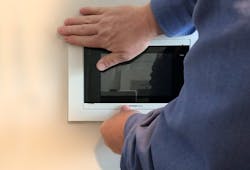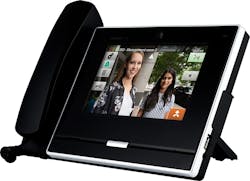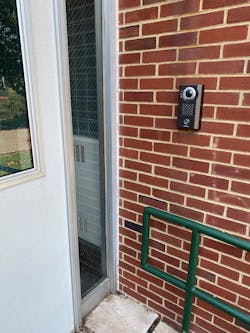4 Tips for a Top-Notch Intercom Installation
Intercom and security communications remain the cornerstone of perimeter physical security protection and detection. These systems handle access and door control efficiently, yield critical audio and video, and increasingly pair well with other integrated systems and services.
In multitenant properties, such as apartment buildings, intercom communications can be spread over vast areas, yet still centralize security effectively on-site or remotely. An IP, or internet, intercom system streamlines a building’s security.
Video intercoms manage visitor access across an entire campus of networked buildings, which saves on staffing and total system costs. One person can control access and monitor spaces across a series of networked locations, all while being off-site.
Video door stations allow entry only by authorized people and provide additional security screening for sensitive or regulated areas. Wall boxes and emergency towers protect outlying areas and parking lots for a safe and secure environment.
So, intercom and security communications make sense for many customers and facilities, and there are ways to ensure an effective installation from start to finish. Here are four important tips to remember as you design your intercom and security communications project.
1. Follow Network Standards
IP audio and video intercom systems leverage the existing infrastructure to make communication between buildings a breeze. They collect historical data for accountability, record keeping, compliance and regulations, and they’re managed and controlled easily by using smart devices and computers. There are, however, standard technical limitations that must be followed for optimum connectivity and system effectiveness.
In any type of intercom system, IP or hard-wired, an intercom is located at an entry point, and some centralized “head-end” location provides communication between the two. If it’s a networked intercom, a network cable drop will be required for termination at both points. When using structured cabling, such as Cat-6, the maximum cabling length is 100 meters, or about 328 feet.
With any networked system, whether cameras, intercoms or computers, you have a hard limit from a switch, typically a Power over Ethernet (PoE) switch. If you stay within these parameters, communications will be reliable and uncompromised. If you exceed that, however, the networked station isn’t guaranteed to work properly.
2. Coordinate with IT
Anytime you install a new system, it’s a best practice, if applicable, to get the IT department involved early and throughout the process. This is the person or team who manages network switches, opens ports and provides approved IP addresses. If the intercom system will be accessed through a smartphone app, certain websites and IP addresses will have to be authorized or cleared in advance by IT.
Working directly with IT is a huge factor in the success of your installation. For example, if you don’t set up this collaboration initially, you could be delayed for weeks while trying to get approvals.
In a mixed-use setting, such as a high-rise that includes offices where privileged information is affected, you might have to consider the Health Insurance Portability and Accountability Act (HIPAA) or other compliances and regulations. Talk to IT and explain how the intercom system will function, so they can assist and provide other valuable input, and provide an implementation schedule.
Getting IT buy-in from the beginning is always best. But you also might consider establishing a stand-alone, dedicated network that uses a PoE switch for communications. Such a network doesn’t touch the customer’s network and therefore might be more palatable to the end user.
3. Use the REX
Do you have a request-to-exit (REX) input available? If so, that will make the installation a lot easier and more straightforward.
In this type of installation, your intercom is part of an electronic access control (EAC) system that includes credential readers and systemwide reporting that indicates when a door is opened and initiated by the intercom. The REX input allows for any contact closure to then activate the door release. The beauty of this type of EAC system is that the REX input is standard. This makes for a simple connection from a door station or head-end station.
The other benefit of having a networked system is you can drop a relay switch into the main distribution frame (MDF) closet, with minimal wiring required to the panel. In addition, when using a REX input, you don’t have to worry about the wiring particulars or the characteristics of strikes, maglocks or other door controls, because the REX input won’t exceed the limitations of the intercom’s contact capacity. Wiring the same contact to the lock could exceed the intercom’s contact rating and damage the contacts.
However, an intercom also might be wired to release a door by connecting directly with a strike or maglock. Those openings can be configured as fail-safe or fail-secure. Fail-safe openings will disengage or unlock in the event of an emergency or power outage, so people can exit freely. In fail-secure openings (used in critical infrastructure or other high-security applications), the door remains locked.
Delayed egress, which allows passage after a specified period allowed by the local authority having jurisdiction (AHJ), also might be configured in the EAC system, so keep that in mind.
4. Do a Power Check
The REX input also helps to eliminate potential problems, such as pulling too much power or power amperages not being supported. Does the intercom support 1 amp, 2 amps or more? Depending on the answer, you might have to add a secondary power relay to bridge the lock interface. If the lock is looking for 4 amps and your system provides only a half-amp rating, you should add a relay that can handle the current pulse to avoid pulling too much power and burning out the contacts on the back of the intercom.
Do a quick power check:
- What type of electric strike or maglock is being used?
- Can your power source support the intercom?
- Is the contact rating correct?
- Is it pulling the right amount or too much power?
- How many amps does it support? (If power isn’t supported, consider a secondary relay.)
Intercoms can help to move an EAC system forward technologically. As a result of the COVID-19 pandemic, the move to touchless solutions has accelerated. Intercom communications now incorporate the latest hands-free technologies that eliminate the necessity for a person to touch a surface when requesting access. When they’re integrated with an access control solution, the intercom system detects motion within a preset range or uses a hand wave for hygienic and quick through-put.
As locksmiths continue to move into the digital era, networked intercom and security communications can help them to futureproof their business and engage customers with valuable solutions. IP intercoms integrate with access control, camera systems, paging, notification and SIP phone systems. These features and other capabilities increase system flexibility and scalability, which leaves room for future growth and expansion as the end users’ demands change.
Paul Hefty is the manager and senior technical services engineer for Aiphone.
Paul Hefty
Paul Hefty is the manager and senior technical services engineer for Aiphone.








